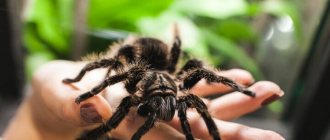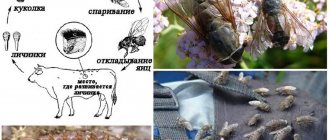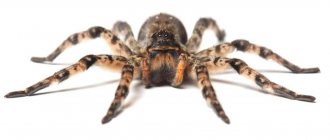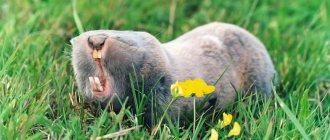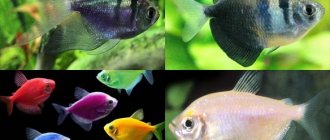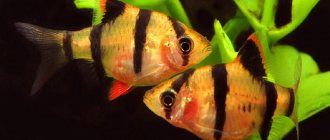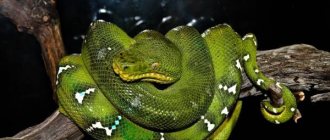- Wild animals
- >>
- Insects
The horsefly is a large insect that will bite you at the first opportunity. They are 1.3 to 2.5 cm long, triangular and carnivorous. When they bite, they take out a piece of meat and inject poison. The area around the horsefly bite will be sore for about five days. Horseflies are also important vectors of diseases such as turkey leukocytosan disease.
Origin of the species and description
Photo: Horsefly
The horsefly is a representative of the horsefly insect family (order Diptera), or more precisely, a representative of the horsefly genus. These plump flies, about the size of a housefly or the size of a bumblebee, are sometimes called green-headed monsters. Their metallic or iridescent eyes meet dorsally in the male and separately in the female.
Their mouth resembles a wedge-shaped miner's tool. Other names for the insect are bat and bat ear. One of the most common species (Tabanus lineola) has bright green eyes and is known as the green head. The genus of lacewings, commonly known as deer flies, are slightly smaller than horse flies and have dark markings on their wings.
The multiple, painful bites of large populations of these flies can reduce milk production in dairy and beef cattle and interfere with grazing of cattle and horses, as attacked animals will cluster together. Animals can even get hurt while running away from these flies. In this case, blood loss can be very significant.
Video: Horsefly
These large, stout-bodied flies are powerful and agile, circling or stalking their targets with humiliating persistence to inject painful stabs into the skin and suck blood. The flies only stay in contact with the host for a few minutes and then they move away until they need to eat again, which happens every 3-4 days.
A serious allergy to horsefly bites is not common, but it may be signaled by additional symptoms:
- feeling dizzy and weak;
- dyspnea;
- temporarily swollen skin, such as around the eyes and lips.
More severe allergies are rare but are an emergency.
You should call an ambulance for any signs of anaphylaxis, which include:
- swelling, itching, or rash;
- your face, lips, arms and legs are likely to be swollen;
- swelling of the throat and tongue are dangerous symptoms;
- nausea, vomiting or diarrhea;
- difficulty swallowing or breathing.
Who is the gadfly?
Gadfly is a generalized collective name for parasitic flying insects. There are about 150 species in total, which, in turn, are divided into 3 groups:
- Cutaneous (subcutaneous).
- Cavity.
- Gastric.
bull gadfly
The names of these subspecies were not given by chance. Scientists were guided by where flies lay eggs. Therefore, gastric gadflies are those that seek to lay eggs near the animal’s mouth (or on those areas that it licks) so that after the eggs, and then the larvae, they can end up in the digestive system of the victim. Skin gadflies behave somewhat differently. They attach future offspring to the skin or hair of animals (less commonly humans). After which the larva, biting into the skin, itself penetrates the body to parasitize it. - viviparous insects. Females of this species can give birth to larvae and during the flight spray them into the eyes, nostrils of an animal or person. Then they parasitize on the skin of the eyelids, mucous membranes of the nasopharynx or eyes, and even inside it.
Moreover, outwardly, any gadfly looks like an ordinary fly. The length of its body does not exceed 20 mm. The body is mostly shaggy. The color is most often dark with orange tints. But there are also individuals with more “calm colors” - dark brown, coal-black or gray-blue. Gadflies are distinguished by their large heads with pronounced large eyes. The wings are transparent and miniature.
Gadflies relatively rarely attack humans (with the exception of Dermatobia hominis, living in South and Central America). Although they like to annoy him with their importunity. Of particular interest to them are animals and livestock, which these insects need for procreation.
In some regions, gadflies are called spiders. Another popular name for this insect is string.
Appearance and features
Photo: What does a horse fly look like?
The horsefly is a dark gray fly with gray-brown mottled wings and intricate striped iridescent eyes. Adult flies are brownish, hairy, strong, about 1.7 cm long, and resemble honey bees in appearance, except that they have only one pair of wings. There are faint smoky spots on the horsefly's wings.
Fully grown larvae are 0.6 to 1.27 cm long and have dense, yellowish-white or pinkish thick skin. They are blunt at one (posterior) end and taper to the other (anterior) end, which has a pair of robust, hook-shaped mouthparts. Each body segment is surrounded by strong spines. The antennae of horse flies have five segments and are thick at the base, becoming thinner with each segment. These antennae are long and thin. The wings of horseflies are usually completely dark or completely transparent.
Fun Fact: The easiest way to spot a horsefly is to look at its overall size. The insect tends to be large compared to other biting flies. Males have eyes so large that they touch the top of their heads.
Not all horse flies depend on water, but many species lay their eggs on plants growing near ponds, rivers and streams. The larvae of some species are aquatic, while others live in moist soil. All feed on other invertebrates until they are ready to pupate and become adults. This means you are more likely to encounter larvae around bodies of water. Farms are often a hot spot for these flies as they are attracted to livestock and horses.
Now you know what happens when you are bitten by a horsefly. Let's see where this insect lives.
Types of insects
Commonly encountered species of the described insect include:
- Bullfly - considered the largest species of the described family, reaching a length of about 20 mm. The bullfly is a two-winged insect belonging to the horsefly family. This species of horsefly lives in Europe, colored brown, with dark stripes located along the body and yellowish hairs.
- Lacewings or moths - about 250 species of horseflies are equated to the described genus. The most common horsefly is the common lacewing, reaching a length of 14 mm and having a rather bright color of its body. The chest of this insect has a blackish color, while the abdomen is complemented by original yellow spots. The wings of the lacewing have a mosaic color, the top of which is completed by brown spots located on them. The huge faceted eyes cast an emerald-golden color;
- An ordinary raincoat - with a modest color and wings with a complex smoky pattern. The described type of insect can produce, so to speak, a real horsefly bite, even in gloomy and cloudy weather.
Where does horsefly live?
Photo: Insect horsefly
Horseflies usually live in forests. The species typically feeds during the day and is most visible on calm, hot, sunny days. They are commonly found in both suburban and rural areas near bodies of water that serve as breeding grounds and where mammalian hosts are most abundant.
The larvae develop in the gastrointestinal tract of host animals during winter. At the end of winter and at the beginning of the spring months, adult larvae are found in the host's feces. From there they burrow into the soil and form a puparia from the skin of their last instar (instar) larvae. They develop into adult flies inside the puparium and emerge after 3-10 weeks.
Adults are active from mid-summer to autumn. Adult females lay eggs on the hair of horses, especially on the hair on the front legs, but also on the belly, shoulders and hind legs. The eggs hatch in 10–140 days with the proper stimulus (moisture, heat, and friction) caused by the horse licking or biting egg-infected hair.
The tiny first instar (instar) larvae enter the mouth and burrow into the tongue for approximately 28 days before they molt and move into the stomach where they remain for 9-10 months, developing into the third instar after approximately 5 weeks. One generation of horse flies grows up per year.
Life cycle of a gadfly
The gadfly is an insect that has a closed chain of transformations. In the full cycle of its development (with rare exceptions), it passes from the egg to the adult state (imago), passing between the forms of first a larva, then a pupa. It takes the gadfly about a year to do everything.
At the first stage of the life cycle, the female insect lays eggs. Ideally, on the body (or inside the body) of the animal; as a last resort - somewhere in the grass (so that the animal can swallow them along with food).
Once in favorable conditions, the eggs become larvae, which quietly mature in the warmth until the right moment, and then fall out of the animal’s body along with feces or exit through the skin.
After some time, the larva turns into a pupa, which, in turn, turns into an adult.
An interesting point: a mature insect does not need nutrition! It has enough reserves accumulated by the larva during its “residence” in the animal’s body, and then in the “hypostasis” of the pupa. True, the adult does not live long - only three to four days. Her main task is to have time to give birth to offspring, and at this point the “mission” is considered completed.
This is the “meaning of life” of the gadfly, an insect whose photo can be seen in this article.
What does horsefly eat?
Photo: Greater horsefly
Adult horse flies usually feed on nectar, but females require blood before they can reproduce effectively. The bites of female horseflies, especially large ones, can be quite painful because their mouthparts are used for tearing and grinding, unlike mosquitoes, which simply pierce the skin and suck blood. They have jagged, saw-like teeth that cut open skin, then release an anticoagulant to stop blood clotting while they enjoy their meal.
Fun fact: Female horse flies require up to 0.5 ml of blood to reproduce, which is a large amount compared to their size. They can draw about 200 mg of blood in a few minutes.
Horsefly bites can develop into large, red, itchy, swollen bumps within minutes. Some people also report feeling hot, weak and nauseous. For most, they are completely harmless, but extremely inconvenient. In extreme cases, some people may suffer from an allergic reaction with symptoms such as dizziness, wheezing, difficulty breathing, blotchy skin rash and severe swelling that may be visible on the lips or tongue.
Horseflies are intermittent feeders. Their painful stings usually cause a response from the victim, forcing the fly to move on to another host. Consequently, they can be mechanical carriers of some animal and human diseases. Female horseflies are also persistent and will typically continue to bite their host until they either succeed in acquiring their blood meal or are killed. They have even been known to pursue their intended goals for short periods of time. Some species carry disease-causing organisms, but most fly-borne diseases are associated only with livestock.
During outdoor activities, wear light-colored clothing and insect repellent to prevent horsefly bites. If they enter structures, the best method of control is exclusion, including checking all doors and windows.
Consequences of a bite
The consequences of a gadfly bite are swelling, allergies. Pregnant women may experience fetal death, premature birth, or miscarriage.
Infection of a wound can contribute to the development of an inflammatory and infectious process, including blood poisoning (sepsis) and bacteremia (high levels of bacteria in the body).
Tetanus and gas gangrene may develop.
Allergic reaction
A person who is bitten by an allergy may experience an attack of suffocation or anaphylactic shock. Maybe even coma, and then death.
Features of character and lifestyle
Photo: Bullfly
Adult horseflies are fast, strong fliers, capable of flying more than 48 km, although they do not usually spread widely. Most often they attack moving and dark objects. Horseflies often rest on paths and roads, especially in forested areas, where potential hosts await them. Flies are attracted to light and sometimes congregate in windows. Horseflies are more common in hot, sunny weather with little wind, such as during the daytime in midsummer. They can become more of a pest when thunder accompanies hot weather.
Horseflies are diurnal, meaning they are active during the day. They prefer to feed on the blood of livestock such as cows and horses. This can be problematic because horse flies carry pathogens that can cause disease in some livestock species, leading to potential economic losses. And unfortunately, horseflies have no problem feasting on people or pets if given the opportunity.
Fun Fact: Like other blood-sucking insects such as mosquitoes, female horse flies use both chemical and visual cues to locate their hosts. Carbon dioxide emitted by warm-blooded animals provides a long-range signal to attract flies at a distance, while visual cues such as movement, size, shape and dark color serve to attract horse flies over shorter distances.
Means of protection against gadflies
As we have already said, adult individuals do not have mouthparts, do not feed, and do not sting. The supply of nutrients that they accumulated in themselves in the larval stage is enough for them. But when the larva pierces the skin, it can be called a bite. If you discover a gadfly bite, treatment should not be delayed. Of course, it is best to immediately consult a doctor, but if this is not possible, then you can try to remove the larva yourself. The first thing you need to do is take a thick, sticky or greasy product (tape, Vaseline, PVA glue) and apply it to the gadfly bite. In this case, oxygen will not enter the chamber and the larva will partially crawl out. Next, you need to carefully pull out the larva without crushing or tearing it. The bite of a gadfly precedes swelling, swelling and infection of the skin, so it is necessary to disinfect the wound. Below are photos showing a gadfly bite and the consequences it causes.
When it comes to animals, regular livestock inspections should be carried out. If larvae are detected, it is necessary, again, to lubricate the damaged area with Vaseline (or another product). Then you need to carefully remove the larva so that it does not rot and cause skin infection. At the end, be sure to treat the gadfly bite with an antibacterial agent.
Gadflies react to the smell of sweat and other strong odors, so it is necessary to follow hygiene rules, especially on hot summer days. You can protect yourself with sprays and creams against mosquitoes and other insects. There is also a folk remedy for horseflies and gadflies: a leather strap or lace soaked in Vishnevsky ointment. Gadflies are also repelled by the smell of birch tar, so this remedy can be used in the same way. It is believed that animals sense the approach of gadflies. They begin to behave strangely: shaking their heads, running, beating their tails. How they distinguish the gadfly from other flies is unknown. Unfortunately, human hearing and touch are not able to detect gadflies among many other flies, but now you know what this parasite looks like and how to protect yourself and your animals.
Social structure and reproduction
Photo: Large horsefly
Horseflies undergo a complete metamorphosis, which involves going through 4 complete life stages. These are the egg, larva, pupa and adult stage. Females lay batches of 25 to 1,000 eggs on vegetation that is above water or wet areas. The larvae that hatch from these eggs fall to the ground and feed on decaying organic matter or small organisms in the soil or water.
Horsefly larvae develop in the mud along the edges of a pond or the banks of streams, wetlands, or seepage areas. Some are aquatic and some develop in relatively dry soil. The larval stage usually lasts from one to three years, depending on the species. Mature larvae crawl into drier areas to pupate, and adults eventually emerge. The duration of the pupal stage depends on the species and temperature, but can vary from 6 to 12 days.
It is difficult or almost impossible to find and eliminate the breeding site of horse flies. They breed in environmentally sensitive wetlands, so the impact of drainage or insecticide applications on non-target organisms or water supplies is of concern. In addition, these insects are strong fliers that can move from some distance. Breeding sites may be very extensive or some distance from where problems occur.
Fortunately, horseflies are a sporadic problem during certain times of the year. Some behavioral adaptations or use of repellents may allow outdoor enjoyment.
Habitats
In total, the horsefly family has slightly less than 4,500 thousand species. These insects are distributed throughout the planet. Bullflies were found even at an altitude of 2 km above sea level. They are absent only on remote islands and Antarctica. There are 200 species of horseflies in the CIS.
Insects prefer places with high humidity. Horseflies are flies whose larvae develop in an aquatic environment. Some of the larvae are predators, feeding on small inhabitants of the reservoir. Others eat rotting plant parts. For this reason, accumulations of insects are usually observed near bodies of water. Up to 20 species of horseflies can be found in the same area.
On a note!
They are all an important part of the ecosystem. Horsefly larvae living in water contribute to soil enrichment. Adult horse flies are eaten by a significant number of birds and animals.
Insect horsefly
Natural enemies of horse flies
Photo: What does a horse fly look like?
Along with many other flying insects, horse flies are also a key food source for many other animals higher up the food chain. They help support other species such as bats and birds, while the aquatic insect larvae feed on fish.
Birds that feed on horse flies:
- Black-headed cardinals are songbirds with large, tapered, thick bills. Their color depends on the sex of the bird: the flame male has an orange cinnamon body with a black head and black and white wings, while immature males and females are brown with an orange patch on the chest. They prey on various insects, including horse flies and caterpillars. Black-headed cardinals can be found primarily in the western United States in thickets and forest edges, as well as in yards and gardens;
- Sparrows are one of the most common birds in North America and are seen primarily in flocks. It is known that if there are insects in the garden, including horseflies, then sparrows can become a nuisance to your home if they become overpopulated. They build their nests in the walls of the house, destroying the forest. Their feces can also pose a risk to human health. Despite this, they can go a long way in reducing horsefly populations around homes;
- Swallows feed primarily on insects, as well as grains, seeds and fruits, and live near fields and areas with plenty of flying space and a natural supply of water. They are fast-flying songbirds that range in color from pale brown to blue-white and are found across much of North America. Flying insects such as horse flies are the swallows' main food source;
- Warblers are insectivorous birds that feed on spruce buds and horse flies. Their population often fluctuates in proportion to the population of the insects they eat. There are about 50 different species of warblers. They are small songbirds with white underparts, green backs and white eye lines. Juvenile warblers are dark green with a distinctive pale eye line and pale yellow underparts.
The danger of gadflies
There is no doubt that the question of whether gadflies are dangerous must be answered in the affirmative. After all, during their development they feed on various tissues of the animal: abdominal, subcutaneous or gastric.
With their huge population, when one animal was introduced, the death of the latter occurred. Sheep, in particular, are often exposed to such danger, whose cavitary botflies cause great harm to livestock production.
Despite the fact that the female tries to divide her offspring among different owners, it happens that there can only be one cow or horse in a certain place. In this case, the entire portion of more than half a thousand eggs will go to one animal. Sometimes this can lead to the death of the latter.
Notes
- ↑ 1 2
Teskey, HJ
The horse flies and deer flies of Canada and Alaska (Diptera: Tabanidae)
. The insects and arachnids of Canada, Part 16. - Ottawa: Agriculture Canada, 1990, 381 p. [www.esc-sec.ca/aafcmonographs/insects_and_arachnids_part_16.pdf Text] (English) (Accessed March 19, 2012) - Life of animals. Volume 3. Arthropods: trilobites, chelicerates, trachea-breathers. Onychophora / ed. M. S. Gilyarova, F. N. Pravdina, ch. ed. V. E. Sokolov. — 2nd ed. - M.: Education, 1984. - P. 402. - 463 p.
| This is a draft article on entomology. You can help the project by adding to it. |
| : Incorrect or missing image | To improve this article it is desirable:
|
Harm
An insect bite is dangerous to humans. It causes pain and can provoke an allergic reaction. Together with saliva, when bitten, toxic substances enter the wound on the human skin, causing swelling. They contain anticoagulants that prevent blood clotting.
Insects often become carriers of infectious diseases that can infect humans. Pathogenic microorganisms carried by horse flies are also dangerous for livestock. They often cause the death of animals.
